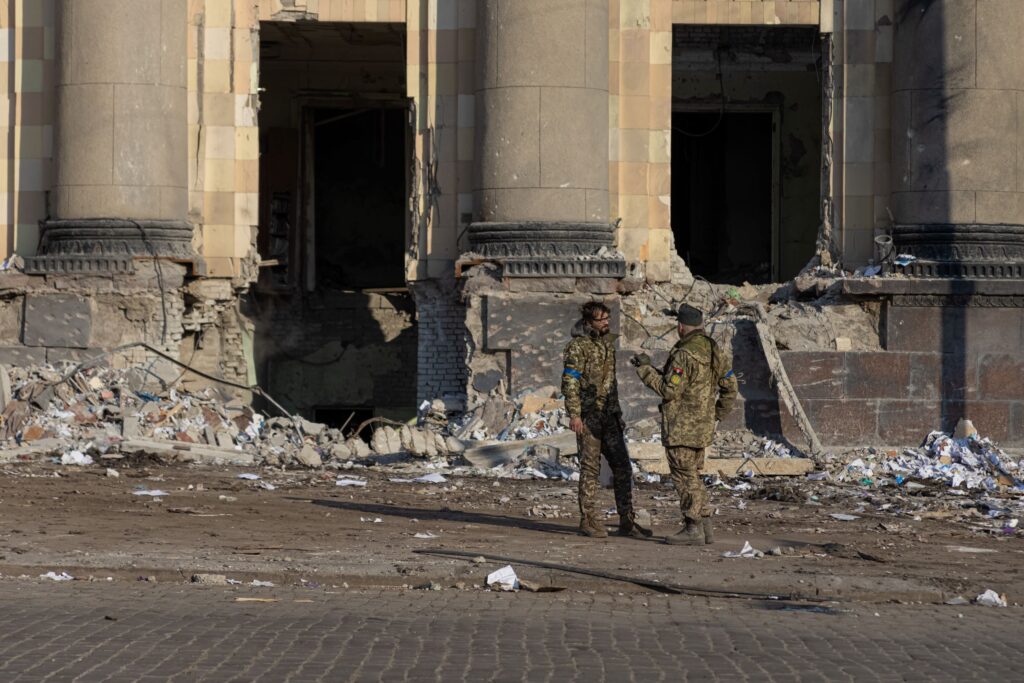Ten hours before Russia’s invasion of Ukraine, I was in Kyiv. I responded to a knock on my door to find my Belarusian flatmate asking for advice. She and her partner had recently fled political persecution in Belarus and weren’t thrilled about packing up again. What did I think? I said it was imperative she left immediately—not tomorrow, but tonight.
For months we had been reading intelligence assessments claiming an invasion was likely, even telling us the exact day. Each time, it would pass with no invasion. But tomorrow it’s really happening! No matter how convincing the intelligence and how clear the indicators were, there was an equally legitimate sense of incredulity. I didn’t expect to see any action in Kyiv, let alone from afar, so I was heading to the eastern city of Kharkiv to see things for myself.
As I left, the ambient mood around me was anxious and uncertain. War would be terribly costly for Russia: a fractured Europe would unite, Russia would become a global pariah, foreign investment would flee, and sanctions would pile up.
But with each passing day and escalation, it had been getting harder to argue Russia’s troop buildup was mere saber-rattling. Those who couldn’t bring themselves to predict a full-blown invasion had to gradually cede ground to the “alarmist.” At first, they chalked up Russia’s military buildup to being a means for coercive diplomacy, then a prelude to annexing the Donbas republics, and then it was preparation for a limited incursion in Ukraine’s east.
Just days before the full invasion, Russia moved troops into the breakaway republics of Donetsk and Luhansk and officially recognized them as sovereign. In the early morning, the Russians evacuated their embassy in Kyiv. A plume of smoke could be seen from inside the walls as they destroyed sensitive documents. I wasn’t prescient enough to predict the scope of the coming “special operation,” but I did recognize there was no turning back.
Some friends were waiting for me in Kharkiv, and so I made my train and began to head east.
Just in Time for War
At 5 a.m. the next morning, I got a flurry of notifications—explosions could be heard in Kyiv, and firefights were reported on the border of Crimea. My friend Collin Mayfield, an American photographer who was already in Kharkiv, messaged me to say that he too was hearing explosions. I had expressed worry the day before when he told me that he booked a hostel right next to the train station. It was an escape route, but also a potential target.
I began to hear voices rippling through the train as, car by car, passengers began to hear the news. The invasion had begun. It was a horrifying but cathartic moment. The alarmists were right all along and I was serendipitously heading right towards the fire. Soon, everyone on the train was awake and glued to their phones. The mood was frantic but quiet. Ukrainians, especially those living in the east, had been ruminating over this possibility for a decade. Someone was listening to president Zelensky’s speech on their phone’s speakers. “I address all Ukrainians, and primarily Ukrainian servicemen, who have already taken the first enemy’s strike and are repelling it with dignity.”
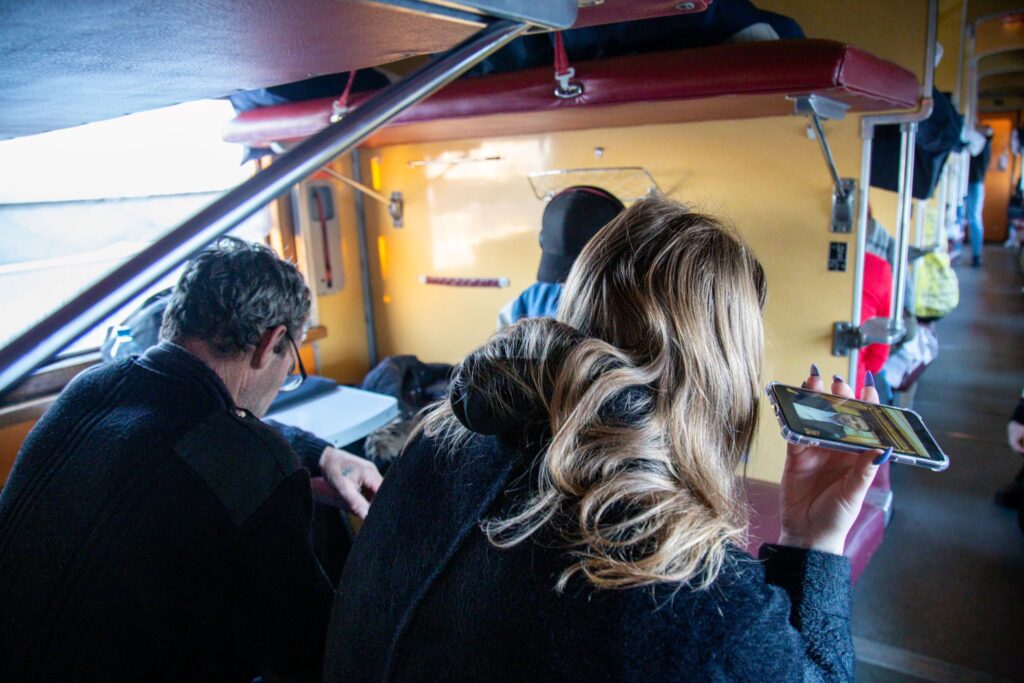
When I arrived in Kharkiv, it was rush hour in the other direction. Thousands were frantically boarding what they thought would be the last train west. Collin and I made our way to the hostel, but they kicked us and all the other guests out as the owners fled town. We headed for the Kharkiv Palace Hotel, hoping for better luck. It was right next to several government buildings that were obvious targets for Russian strikes but there is no such thing as a risk-free decision.
The hotel was in pandemonium. At around 10 a.m., we received reports that Russian troops had surrounded Kharkiv. Terrified guests were scrambling to organize a ride, and gauging the best escape route. One media team from France wouldn’t take their local fixer, a previous Ukrainian military member who they feared might be on Russia’s “list,” and thus a liability should they be apprehended at a newly established Russian checkpoint. A number of people, mostly media, had made the call to stay as long as necessary.
For now, it was the right call. As the hours passed by, it increasingly became evident that we were not yet in danger. Battles were going on around the city’s outskirts, but the Ukrainians had repelled the Russians, who were only dug in on the northern front. I prepared my camera gear. A lot of those who remained planned to report on the war as well. WhatsApp, Twitter, and Instagram pumped in minute-by-minute updates on the situation. It’s a problem you quickly discover: even close to the action you still have to spend long stretches of time hunting for information, just like those watching from far away.
But our proximity was invaluable. While shelling continued, one sound was conspicuously absent—the sound of airplanes. Now should have been the moment when Russian air power swept in to establish dominance over the skies. But the moment never came.
It was one of the most inexplicable errors that the Russian army made at the beginning of their campaign. Instead of adequately softening up Ukrainian defenses with their artillery and other high-caliber weaponry, Russian forces relied on their armored divisions and infantry. Perhaps this was because the Russians wanted to avoid civilian casualties and damaging infrastructure, betting on a quick victory and a smooth integration of what they captured into the Russian Federation. It was a decision paid for in Russian blood.
Russia failed to employ several critical capabilities, most peculiarly, the Russian Air Force. The invasion started as any military analyst would expect, with large-scale pre-invasion strikes at dawn that destroyed Ukrainian early-warning radar systems. But Russia didn’t follow up with the logical next step, which would have been to obliterate the Ukrainian Air Force and establish air superiority from the onset. Why is hard to say—one theory is that Moscow was simply hubristic after taking Crimea with no blood spilled and outsourcing fighting to separatists in Donbas. But this campaign is far more ambitious, and the Ukrainians have had eight years to prepare.
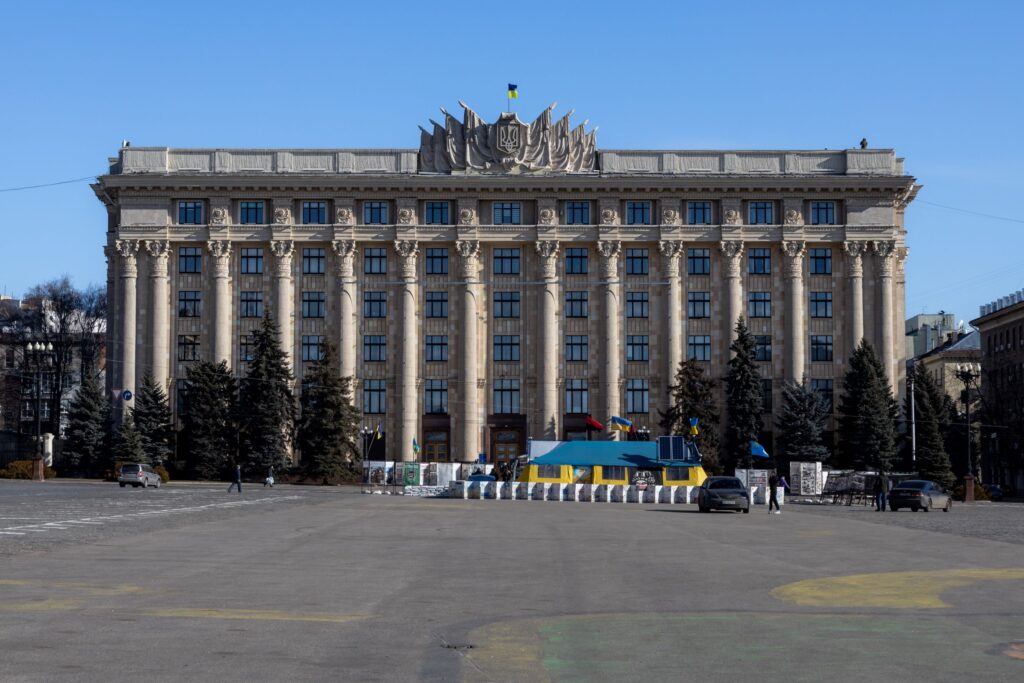
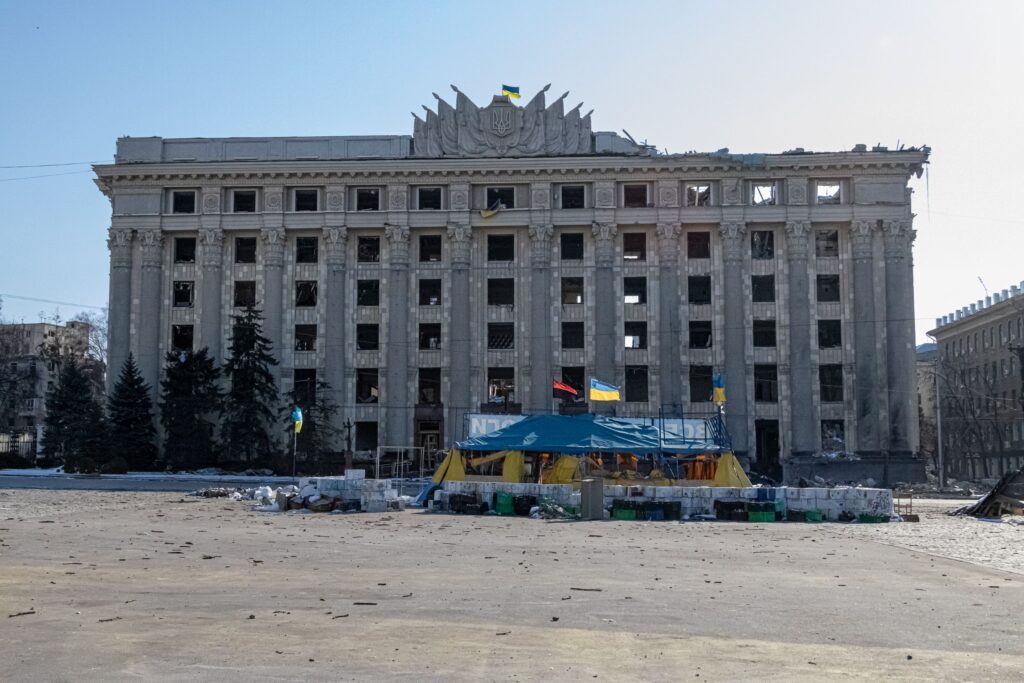
The next day, Collin and I walked down to Freedom Square in central Kharkiv, which was nearly deserted. We were joined by Jack Crosbie from Rolling Stone and Jack Losh from Foreign Policy—it’s good to have numbers in these situations. Spring was in the air and shelling could be heard in the distance. In front of the central administrative building, members of the Territorial Defense Forces were pulling equipment from the trunk of someone’s sedan, loading magazines, and putting on their vests before heading to the front. A few civilian cars were frantically speeding around.
I met 80-year-old Alla Galakhtyonova just outside the local metro station at Freedom Square. She was trying to catch a cab that morning. She had just hitchhiked alone from Donbas. She was trying to reach her sister’s house just on the outskirts of Kharkiv. Thousands like Alla left their homes immediately, heading to another city that hadn’t yet come under siege, or as far west as they could. But for many residents of Kharkiv, leaving wasn’t necessarily the safest option. The metro station had been built during the Soviet era and designed to withstand a nuclear attack. Thousands of residents had been sleeping there every night since the invasion began.
Everyone was anxious to see what form the Russian campaign would take. How quickly would they move? Would Russian troops be launching strikes deep behind Ukrainian lines? What routes would they try to cut off? Complacency kills; whether in Kyiv, Kharkiv, or anywhere else along the line of contact, staying means assuming a risk.
On the 26th, we hired a driver named Vlad, who was willing to drive us to the frontlines. At a checkpoint near the outskirts of the city, we passed a car that had crashed into a concrete barrier. There were no visible gunshots on the windshield. Maybe the driver lost his composure amid the chaos, or had tried to dodge the checkpoint and lost control—it was hard to say. At every grocery store and bank, there were long lines of civilians queuing to get what they needed. Everyone nervously shuffled when a shell landed close. It was still a few kilometers away, but loud enough to terrify and powerful enough to shake the buildings.
On the outskirts of town, we arrived at a Ukrainian position. The Russians had just been stopped here, at an open intersection that cleanly separated the urban from rural. There was little cover. To our left and right, soldiers were hurriedly digging new trenches on the side of the highway. A fierce battle had just taken place and there was plenty of carnage to show for it. Russian uniforms and personal belongings were laying around a destroyed Russian tank, thrown out by soldiers as they scavenged through the wreckage. The Ukrainians appeared to have taken whatever they might need from inside, like ammunition and intelligence. Just up the street was a destroyed Ukrainian armored vehicle. Shell casings, unspent rounds, and other detritus were scattered everywhere. A charred helmet represented a likely casualty, but from which side was hard to say. A destroyed Russian APC was smoldering just behind it.
There was a mutilated, dead Russian soldier lying next to another destroyed APC. Crosbie approached the body to take a photo, coming to the horrifying realization afterward that he was walking on top of fresh snow, and had risked stepping on unexploded ordnance. Whenever possible, you want to walk on solid ground. Others cashed in on his recklessness and retraced his footsteps to get pictures; the Ukrainians appeared to have moved all the other bodies except for this one. A colleague found the reason after a close inspection: there was an unexploded RPG round leaning against his head.
The atmosphere was, if not calm, at least still. The city had been full of frantic energy as people made potential life or death choices. Out here, the soldiers had jobs to do, risk aversion only went so far as their duty permitted. They were digging trenches and checking their kit in diligent silence.
“Fin!” Crosbie yelled to me from down the road. Everyone was running to the trenches, and I sprinted back to join the group. The Ukrainians had just shelled Russian positions and were expecting a volley in return. We could have gone straight to the car and sped out of there, but the trenches were safest. When anticipating rocket or artillery attacks, you assume that direct hits are unlikely. The explosion goes up and outward, so it’s best to get as low as possible.
Luckily, our position was spared from counter-assault. Life on the front lines is often characterized by hours of silence followed by 5 minutes of intense, terrifying action. Soldiers are trained to hurry up and wait. We seized the opportunity to head back to Kharkiv.
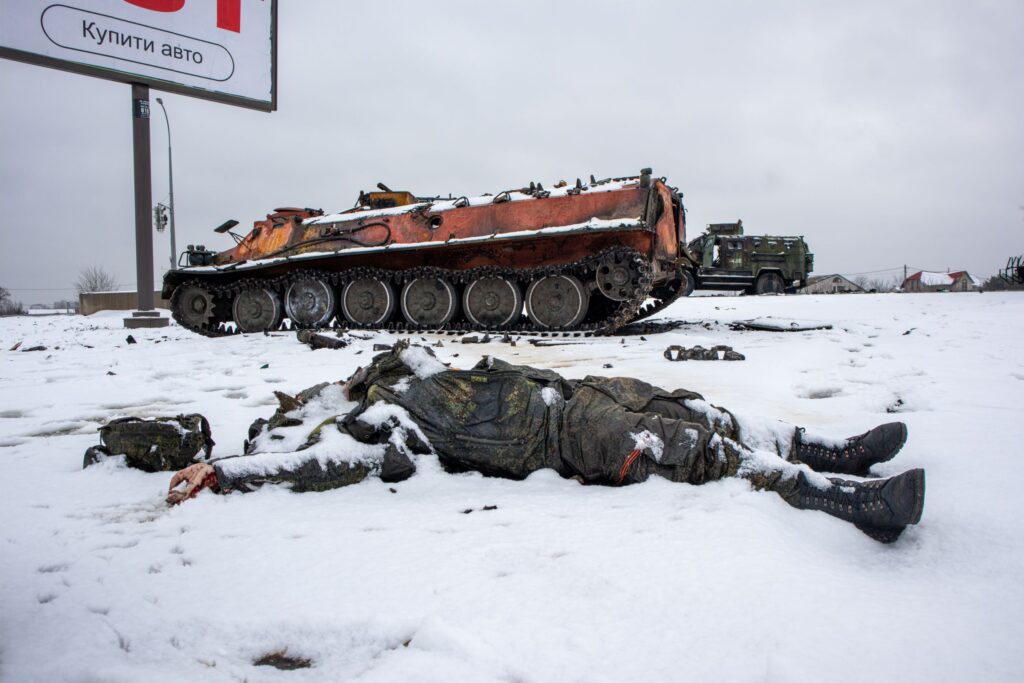


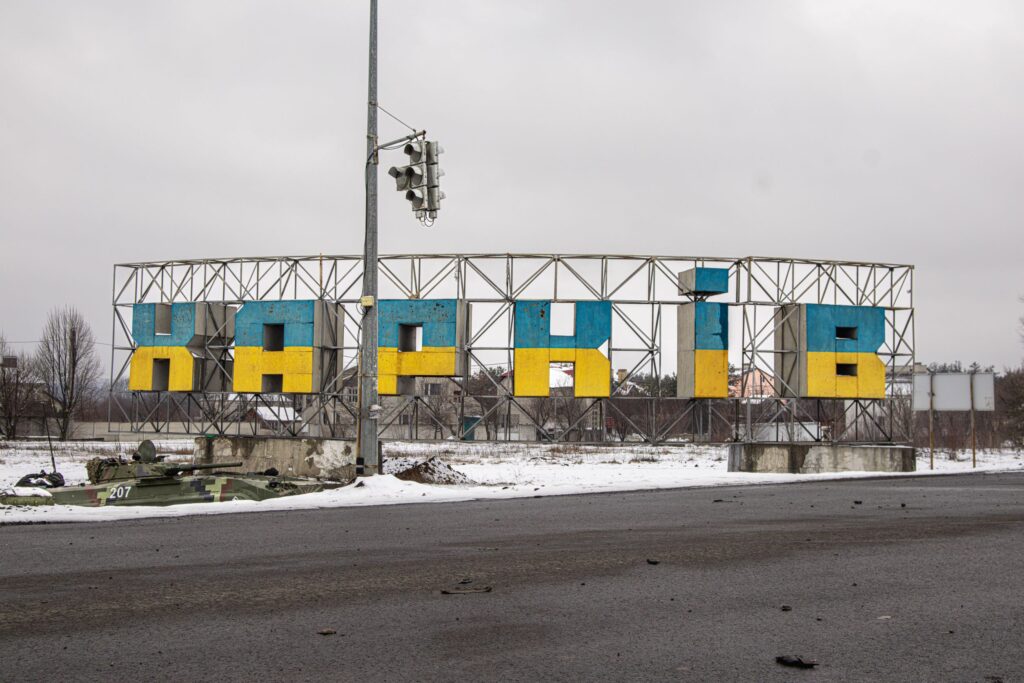
On our way through the city, we stopped at the train station to talk with residents who were fleeing west. Most were heading to Lviv, and then into Poland. There was just one problem: Ukraine is built on the principle that all roads lead to Kyiv. Even though Kyiv was under heavy attack, everyone would have to go there first, then disembark and board a different westbound train. The news was spreading about crowds at the Polish border, though; some people told us they were trying their luck in Romania or Moldova instead. We knew that at some point soon, it was a decision we would have to make too.
Back at the Kharkiv Palace, war was no excuse for bad service. The wifi was working and Coronas still came with limes. Service was punctual, and the staff never showed any signs of fear or discomfort. Up in my room, a cheery advertisement for a local restaurant was playing on TV, as if nothing was awry and I could make a reservation that night if I wished. Maybe I should have. We met a man named Chris in the bar who claimed to know the mob ownership. He told us they had skipped town right before the war started, anticipating what was coming—or maybe even being tipped off. But before they left, they made sure the hotel was stocked with food for a month. The cooks were doing a fine job with it.
In the midst of it all, I got a notification on my phone: martial law was in full effect. Kharkiv Governor Oleh Synyehubov confirmed that all of Kharkiv was still in Ukrainian control and declared a 6 p.m. curfew. Any cars still on the street would be “liquidated.”
Civilian militias had already begun to patrol the streets, stopping anyone who was out in case they were saboteurs. For anyone still in the city, leaving had just become a lot harder. A convoy of territorial defense members loitered just outside the hotel, before speeding away to patrol the city. Heavy equipment and ambulances were moving north towards the front. At dusk, the shelling was sporadic, sometimes coming a little too close for comfort. Some people went to sleep in the basement or hotel lobby with their flak vests at arm’s length.
The patrols came thanks to military preparations Ukraine had made just weeks before the war began. On January 18th, the Ukrainian government officially expanded their Territorial Defense Forces, beefing them up to 25 brigades, made up of 150 battalions, plus volunteers. With each battalion consisting of up to 600 soldiers, the goal was to beef up Ukraine’s total reserves to 130,000 personnel just in time for the invasion. Many more have volunteered since the war began, with Ukraine claiming to seek 1.5-2 million. The Armed Forces of Ukraine are now a patchwork of regular military, police, loosely institutionalized territorial defense, and a variety of militias that aren’t formally incorporated into the command structure.
There are dozens, perhaps hundreds, of videos that show Ukrainian paramilitary groups carrying out extrajudicial detainments, beatings, and torture. The method of choice is taping someone to a street pole and removing their pants. The transgressions? They range from cowardice, to looting, to being a suspected Russian saboteur. Due process is inefficient and costly in the midst of total war. I was detained four separate times during my time in Ukraine, by police, military, and territorial defense members. These recently deputized authorities were worried about journalists revealing troop positions or movements—a very legitimate concern.
By the morning of the 27th, we could hear gun battles for the first time in the city center. The Russians had broken through. Had we missed our escape window? “It’s too late, they’re in the city,” pronounced a photographer with The Washington Post as he put a croissant on his plate. We were all eating breakfast and weighing our options. At some point, we had to take a calculated risk and leave before this building became a target. The photographer may have been right, but I worried that our position in the city center was clouding our judgment. When we did eventually leave, I didn’t want to flee under heavy shelling. As the hours dragged by, the shooting began to grow fainter. Finally, the city went silent. I got a notification: “the Ukrainian Army has retaken Kharkiv!” In reality, they were only in the city for a few hours and so it was never under Russian occupation to begin with.
The Ukrainians had done something ingenious. They purposefully withdrew from their positions and allowed the Russians to move in. It was a trap, and after they had entered the city, the Ukrainians clobbered them from both sides.
This is a military tactic known as defense-of-depth, whereby you purposefully cede ground to the enemy, tricking them into overextending their supply lines and drawing them into a fortified position or trap. When a numerically superior enemy becomes overextended, their troops have to spread out and maintain the advances they’ve already made, considerably reducing their strength in numbers. Ukraine’s cities played a central role in this strategy. The attacker is at a distinct disadvantage in urban combat. Emile Guessen, a former British Royal Marines commando and journalist reporting from Kyiv, explained to me why:
The urban terrain reduces the attacker’s advantage in intelligence, surveillance, and reconnaissance. The defender can see and engage the attacker coming, because the attacker has limited cover and concealment and is often channeled. Buildings serve as fortified bunkers that must be negotiated by attackers. The defender maintains relative freedom of maneuver within the urban terrain.
That night, Collin and I wanted to check if we could see the explosions in the distance, and our friend Chris from the bar was willing to help. He knew the hotel inside and out and took us to a hidden staircase to the top floor. I pointed my camera north. We waited for the fireworks and had a few drinks. Below us, we noticed a police cruiser pull up to a stray man walking around past the curfew. He started running. Bad decision. The police raised their weapons. A single blast echoed up the building. Chris thought he’d been hit, but I wasn’t so sure. Was he a Russian saboteur? Probably not. But martial law is deadly serious, and this wasn’t the place to look for late-night shawarma. The next day in Kyiv, members of the Territorial Defense Units shot a civilian for violating curfew without thinking twice or giving him the benefit of the doubt. Allowing just about anyone to be armed and wield authority has had predictable consequences.

At around 5 a.m. on the 28th, the shelling began like clockwork. I had slept in the staircase to get the right shot. I put on my helmet, turned on my camera, and sprinted downstairs. For the past couple of days, Russian artillery and rocket fire had always started around this time.
Having lost momentum and taken heavy casualties, Russia gave up on trying to capture cities surgically and avoid civilian casualties. That explained the turn from incursions of gunfire to shelling from a distance that Kharkiv experienced. It’s much easier to defend a small number of bombing positions than to storm the city and fight block by block. The Russians meant to avoid constant close-quarters urban warfare.
Across all major fronts, it is Ukraine’s cities that have given the Russians the most trouble. During the storming of Mariupol, multiple ultimatums of surrender were rejected. Meanwhile, Kyiv is far from surrounded, and the Russians are stalled in the nearby towns of Irpin and Chernihiv. To the west of Irpin, on the other side of the Russian flank, Ukraine claims to have retaken the town of Makariv, allowing them to suffocate Russian supply lines. An assault on Odessa will have to wait, as Russian forces still haven’t taken the eastern adjacent city of Mykolaiv. Meanwhile, Ukrainians are continually reinforcing their cities. In Kharkiv, satellite imagery shows the Russians have finally dug in on the eastern flank, taking the M-03 and T-104 highways that lead into the city from that side.
Back in Kharkiv, the shelling was getting louder and closer, it was time to leave. I got a call from Jack: “Pack up. We got a ride, we’re out of here in five minutes.” We were joined again by Vlad, who supposedly knew a safe route south. We moved quickly and hit the road toward the city of Dnipro. Its central location has made it a temporary place of refuge for people fleeing from all the major fronts. Behind us, Kharkiv was being leveled. This was the beginning of the bombardment phase that would continue for over a month: “Everything from the center going northwards, just street after street is blown out,” journalist Neil Hauer later reported from the city. “The people we watched crawl out of the rubble today told us their relatives in Moscow didn’t believe them.”
Jack had planned to be right behind us. But as he was leaving in another car, the new reality came falling from the sky: “A shell landed just a few blocks away,” he later recounted. “Everyone ducked, stumbling. We scrambled out of the parked car and back into the hotel lobby…Ten minutes earlier, we had been the calmest we’d been in days.” Jack and his crew took momentary shelter, watching the skies, trying to guess at the best moment to make tracks. After several tense minutes, they rushed to their vehicle and hit the gas. Soon, they had made it out of the city.
A Long Road Ahead
Vlad wasn’t exactly sure where to go but seemed nonchalant. “There’s a Russian plane flying around this route, but apparently it’s just a UAV so it should be okay.” We passed around a dozen checkpoints between Kharkiv and Dnipro, manned by a mix of regular military and territorial defense units. At one, an older man with an 1800s-era percussion cap rifle worked in tandem with a guy in tactical gear wielding a modified AK-105. At another, hedgehog anti-tank obstacles were inscribed with the slogan, Путин—хуйло (Putin—dickhead). “He will never be able to shake this phrase. Putin will be known by these words for the rest of his life,” prophesied Vlad. If the Kremlin had really expected to be welcomed as liberators across swathes of the country, they made an enormous miscalculation.
The checkpoint outside Dnipro was reinforced particularly well. If Russia manages to push south through Kharkiv, west through Donbas, and north through Zaporizhzhia, one final bloody battle is likely to ensue for Eastern Ukraine in Dnipro. The city still hadn’t been hit by the time we arrived, but the air raid sirens were blaring.
Upstairs at our new hotel, a United Nations group gathered to plan civilian evacuations from Kharkiv. Downtown, territorial defense members were lined up outside a gun shop. We spoke with a father and son from Kharkiv who both had previous military experience and were preparing to enlist again. They had completed their years of combat under multiple different regimes. “I have a military education dating back to the Armed Forces of the Soviet Union,” recounted the father. ”And then I continued serving in the Armed Forces of Ukraine.”
At a volunteer center downtown, sandbags were being prepared, medical supplies gathered, and a large office team was working on logistics. “We have 100 volunteer cars ready. One thing we really need is body armor,” said one woman in military garb. Another woman who just moved from Kazakhstan asked if we could conduct our interview in the hallway instead of the room as it was safer in case of an airstrike. “I came from Almaty to help…There are many of us from different countries here,” she said. “We expect victory!” another volunteer told us, “There are no freer people than the Ukrainians.” The bombast was inspiring. But only time and blood will tell if morale translates into battlefield success. It was time for me to head west for Poland.

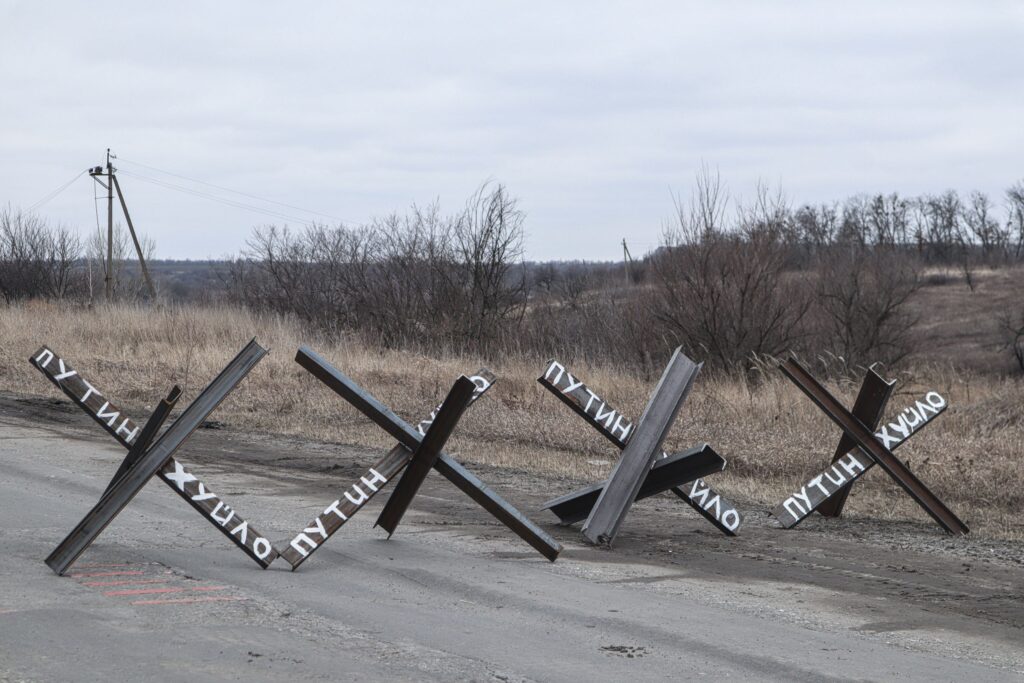
After a few days in Dnipro, Colin and I joined a bus full of refugees going to the Polish border on March 3rd. The 18-hour journey took us through country roads with dozens of checkpoints. At one, a soldier demanded that all men get out to have their papers checked. Not only were they worried about Russian saboteurs, but also-military aged Ukrainian men that might be trying to shirk duty. Driving through the center of Ukraine, far away from the line of contact, we passed town after sandbag-covered town preparing defenses.
At the Polish border, I waited in line with tens of thousands of people for 12 hours. I spoke to one man from Vietnam who went to university in Kharkiv. He, like most people, only had a few small bags. He left under heavy shelling and knew that carrying too much would only slow him down. Kharkiv was a thriving university city; those dormitories and faculty buildings are now mostly rubble.


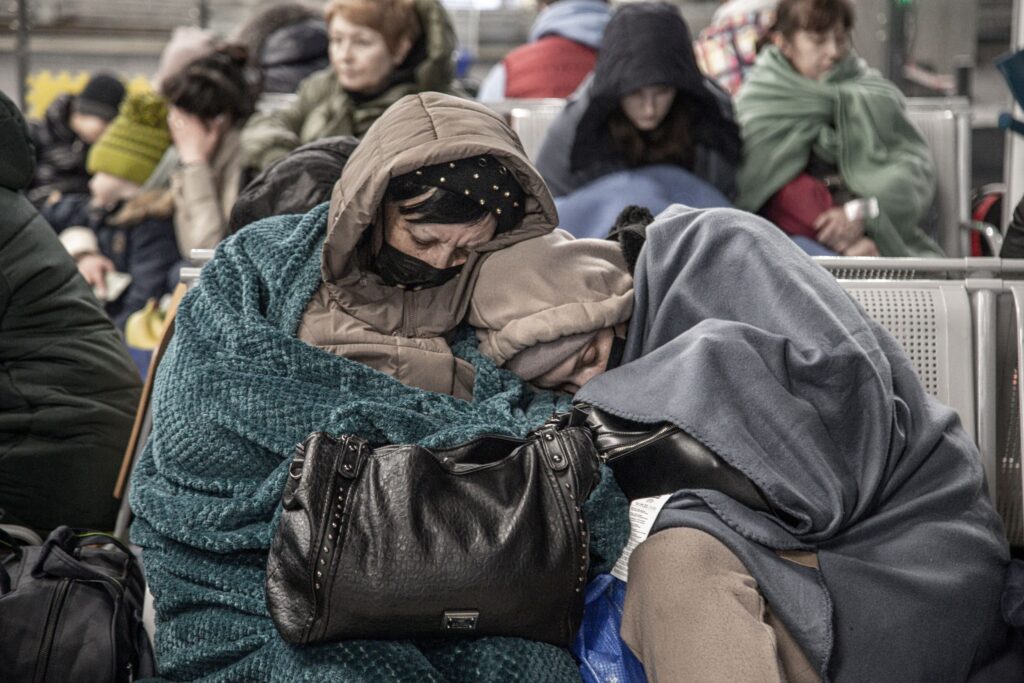
Even if there was a ceasefire called tomorrow with favorable terms for Ukraine, the country has already been destroyed. It’s now estimated that 10 million people have fled their homes and 3.5 million have left the country. How many will return to their destroyed cities? Many will establish new lives in their new host countries. Ukraine already suffered from rampant corruption and economic stagnation before the war. Millions more will flee when they perceive it to be safe, or when they can escape from cities under siege, like Mariupol and Kharkiv. Few people without a deep connection to their homeland will be looking to move back anytime soon. Fewer will be clamoring to return if it means living under Russian occupation.
While the fighting rages on, death toll estimates are remarkably unreliable. Official government estimates should be taken with a large grain of salt, but Western analysts seem to be unquestioningly regurgitating Ukrainian government estimates—sometimes, just reposting data from Ukrainian military Facebook pages. These are bound to underreport Ukrainian casualties and overreport Russian ones.
Practical barriers to obtaining a reasonable casualty count also exist. One analyst turned combat volunteer for Ukraine who was on his way to Kharkiv—we’ll call him Jim—told me that he suspects there are at least 9,000 Ukrainian casualties. “It’s easier to account for regular Russian forces dying because we have their comm traffic and they’re all in uniform. Ukrainian casualties are a mix of regular military, which are well documented, Territorial Defense Forces, which are poorly documented, civilian militias, and civilian collateral damage, which is basically impossible to track in real-time.” In all likelihood, both Ukrainian and Russian casualties are colossal.
Jim was just one of a growing number of volunteers that Ukraine has managed to bring into its ranks. Not all are in it for moral support. While waiting in a Polish refugee processing facility, I came across some mercenaries who had just left Ukraine themselves. The Ukrainian government was demanding they sign an indefinite contract, to which the men refused. Perhaps this policy will change as the war gets more desperate for Ukraine. One of the men had previously completed 10 “contracts” with the Turkish Air Force, but wouldn’t elaborate on their nature.
We discussed the deteriorating security situation in Europe. “The Americans are flying B-52s through Belarusian airspace right now, intimidating the fuck out of Belarus,” the man claimed. Was it true? The deployment of strategic bombers is no trivial matter.
When it comes to escalation maybe it doesn’t matter. By March 3rd, 22,000 additional NATO troops had been moved into Eastern Europe. And the longer the conflict continues, the more room there is for serious error. In the early hours of February 24, the whole world became a far more dangerous place.
